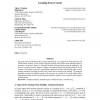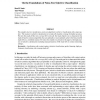83
Voted
JMLR
2010
14 years 7 months ago
2010
We study losses for binary classification and class probability estimation and extend the understanding of them from margin losses to general composite losses which are the compos...
113
Voted
JMLR
2010
14 years 7 months ago
2010
To handle problems created by large data sets, we propose a method that uses a decision tree to decompose a given data space and train SVMs on the decomposed regions. Although the...
112
Voted
JMLR
2010
14 years 7 months ago
2010
For many supervised learning tasks it may be infeasible (or very expensive) to obtain objective and reliable labels. Instead, we can collect subjective (possibly noisy) labels fro...
123
Voted
JMLR
2010
14 years 7 months ago
2010
An algorithm is presented for topology selection in graphical models of autoregressive Gaussian time series. The graph topology of the model represents the sparsity pattern of the...
100
Voted
JMLR
2010
14 years 7 months ago
2010
After building a classifier with modern tools of machine learning we typically have a black box at hand that is able to predict well for unseen data. Thus, we get an answer to the...
106
click to vote
JMLR
2010
14 years 7 months ago
2010
Principal component analysis (PCA) is a classical data analysis technique that finds linear transformations of data that retain the maximal amount of variance. We study a case whe...
113
click to vote
JMLR
2010
14 years 7 months ago
2010
A continuous time Bayesian network (CTBN) uses a structured representation to describe a dynamic system with a finite number of states which evolves in continuous time. Exact infe...
130
Voted
JMLR
2010
14 years 7 months ago
2010
Inducing a grammar from text has proven to be a notoriously challenging learning task despite decades of research. The primary reason for its difficulty is that in order to induce...
109
Voted
JMLR
2010
14 years 7 months ago
2010
We consider selective classification, a term we adopt here to refer to `classification with a reject option.' The essence in selective classification is to trade-off classifi...
62
Voted
JMLR
2010
14 years 7 months ago
2010





